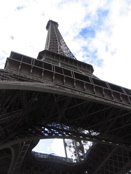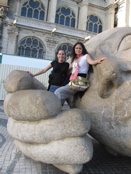The food isn’t the only thing that’s different about donating blood in Paris – for one thing, the required abstention post-tatouage is a mere 4 months, compared to the year-long wait in the U.S., and there’s no minimum required iron level – in fact, they don’t even check.

I tried rather half-heartedly and unsuccessfully to figure out if I was allowed to donate here at the beginning of the school year, but gave up or forgot or was just to lazy to follow through. I’d completely forgotten about it until I checked my Sciences Po email yesterday and discovered that SciPo was hosting a blood drive today.
Still not sure whether I was even eligible to donate in France, I showed up anyway. Since I had an 8am class and was already at school, I was one of the first in the door at 10:30, ready to completely befuddle all of the technicians.
As easily as I can generally communicate in France, there are some things that I just don’t know. My weight in kilograms, for example, or my height in meters. During my interview, I had several technicians gathered around me trying to estimate my height and weight – as they shouted out their guesses, they’d look at me for confirmation, as though hearing the correct numbers would trigger some dormant part of my brain that conforms to the metric system.
It took me a lot of arguing in my American French to convince the médecin that yes, it was possible that I had donated blood maybe 15 times in my life. He kept asking if I was sure, and after thinking about it I realized that it’s probably more like 25 – I’ve been a pretty regular donor since I hit 16 and this new number just completely floored him. À 21 ans? Vingt-cinq fois à 21 ans? he kept exclaiming. Just as I couldn’t figure out why he was so amazed, he couldn’t figure out why I was so nonchalant – until he asked me what the minimum age for donation is stateside. Until a few years ago, French donors weren’t allowed to donate until they were 21 years old. This age limit was lowered to 18 with parental consent, and then finally to 18 without parental consent, so a minimum age of 16 years and 110 pounds was pretty surprising to my poor interviewer.
I had another adventure trying to explain to the médecin that the only surgery I’d ever had was to have my tonsils removed more than a decade ago. I’d been wrongly assuming that the word for tonsil was the same in French – enlèvement des tonsils, enlèvement des tonsils! I kept pointlessly repeating while patting my throat with one hand and miming some kind of tonsil removal with the other. Turns out, “tonsil” is not a word in French, not even close. The correct vocabulary would have been les amygdales, which was probably one of the words the médecin kept saying, but had sounded so far off that I’d disregarded it. The confusion ended with him writing “tonsil” on a piece of paper and telling me that I need to figure out the word for next time.
Once we had the medical history sorted out, it was time for the interview. For the most part, this was exactly the same history I give at Cascade Regional in Tacoma – but even more inclusive, if you can imagine. For example, if you say no, you have not had unprotected sex even one time since 1980 with a man who has had unprotected sex even one time since 1980 with another man, you get another list of questions. Do you have a significant other? Male or female? How long have you been dating? Are you monogamous? Are you sexually active? If so, when is the last time you had sex, and was it with a significant other, or somebody else. I was kind of taken aback by this series – I’m used to the no, no, no to all of the high-risk for HIV diagnostic questions, but not so much to the relationship/sexual profiling ones. They also ask if you’ve ever smoked hash or cannabis – if so, when and in what quantities. I’m not sure what pot has to do with blood quality, but I guess my médecin was satisfied that I probably didn’t have any traces of marijuana in my system today, and I was sent out to be bled.
There were two technicians drawing blood, a man and a woman, and they both seemed very tickled to have an American girl incapacitated on a cot. The man was excited to practice his English, and told me, “Your snow, I mean rain? Snow? Ah yes, boots for rain, are so nice, mademoiselle,” while the woman fussed over me, speaking as slowly as she could, patting my arm, and unzipping and rezipping my sweater whenever she deemed that I might be in need of a temperature adjustment.
I was hoping for some French “I donated” merchandise, but hélas, all I got was a chausson aux pommes, a Mont Blanc yogurt and a compliment on my footwear.
I know parking is an issue in this city, but this guy definitely should have kept looking:

































